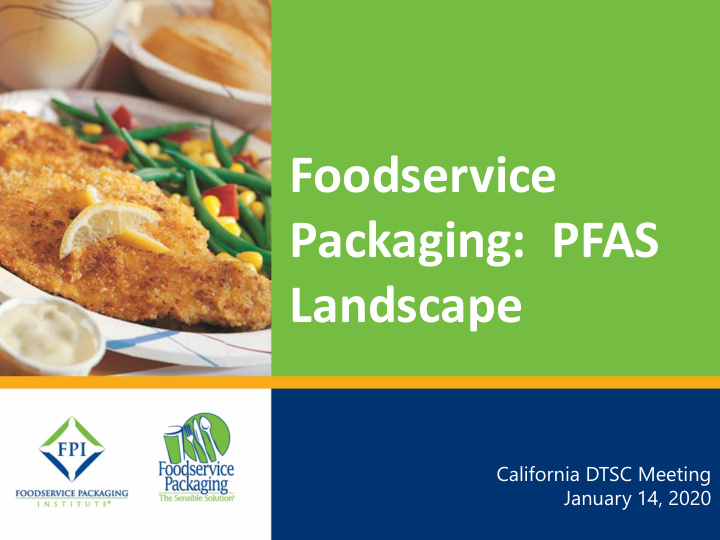



TODAY’S Foodservice FOODSERVICE PACKAGING: Packaging: PFAS INNOVATIONS, ISSUES Landscape AND TRENDS California DTSC Meeting January 14, 2020
Background Started with FPI October 2018 Came from industry; previously handled state and local government affairs and sustainability for Graphic Packaging International Overall, 13 years of government relations experience – operating at international, federal, state and local level. M.A. Political Science from Georgia State University
What is FPI? The Foodservice Packaging Institute Established in 1933 Only industry trade association in North America solely focused on all single-use foodservice packaging products Members include: – Converters and their raw material and machinery suppliers (approximately 90% of the industry); – Foodservice distributors, GPOs and operators
What is foodservice packaging? Foodservice packaging primarily includes single-use products such as cups (beverage and portion), plates, platters, bowls, trays, beverage carriers, bags (single portion and carry-out), containers, lids and domes, wraps, straws, cutlery and utensils for the service and/or packaging of prepared foods and beverages in foodservice establishments. Other related products such as placemats, doilies and tray covers; trays used in packaging raw meat, poultry, seafood, produce, and other food products; and egg packaging are also included. Foodservice packaging is: Sanitary Cost-effective Safe Convenient Resource-efficient Promotional
WHAT ARE PFAS? PFAS = Per- and Polyfluoroalkyl Substances Class of over 3,000 chemicals containing at least one fully fluorinated carbon atom, all with very different properties in different applications
PFAS APPLICATIONS Non-stick cookware and small appliances Repeat-use food contact applications (e.g. tubing and hoses in soda and ice cream dispensers) Components of food processing equipment (e.g. gaskets, sealants and filters) Food wrappers Paper/molded fiber service ware and take-out food containers Food boxes (e.g., pizza boxes) Microwavable bags (e.g., popcorn) Pet food containers
PFAS IN FOODSERVICE PACKAGING Purpose: Prevents oil and grease from seeping through food packaging materials and onto clothing, skin, furniture, car interiors, etc.
SUB CATEGORIES OF PFAS “ Long chain” or “C8” chemicals, since they have 8 or more carbons in their structure − Perfluorooctanoic acid (PFOA) and perfluorooctane sulfonic acid (PFOS) are two examples − These were voluntarily phased out and are no longer allowed in the U.S. and Canada, but still allowed in other countries
SUB CATEGORIES OF PFAS “ Short chain” or “C6” chemicals, since they have 6 or less carbons in their structure − Manufacturers of these newer chemicals submit their specific formulations to regulatory agencies for rigorous review and, if found to be safe for their intended use, may be used − Are approved by FDA and Health Canada, plus many other regulatory agencies around the world
FDA REVIEW OF PFAS USED IN FOOD CONTACT APPLICATIONS FDA requires pre-market review of food contact substances, including data on: − Chemical composition, including all impurities and potential degradation products − Levels of substances (including impurities and degradation products) that may be released under intended use conditions and the resulting potential dietary concentrations − Toxicity data on the substance, including all impurities and degradation products
FDA REVIEW OF PFAS USED IN FOOD CONTACT APPLICATIONS Data must demonstrate the substance is safe for its intended use (reasonable certainty of no harm) FDA can withdraw its acceptance if available data no longer demonstrates the substance is safe for its intended use Today, there are less than three dozen PFAS chemicals allowed by the FDA in the U.S.
RELATED TO THE SAFETY OF PFAS A robust body of scientific data demonstrates that the specific PFAS substances allowed by FDA for use in food packaging today present no significant risk to consumers Resource: https://fluorocouncil.com/health- environment/scientific-studies/
RELATED TO THE SAFETY OF PFAS Using FDA’s methodology for calculating estimated dietary intake, the maximum levels of PFAS used in food packaging today are 13,000 times lower than estimated safe levels, meaning the specific PFAS substances approved by FDA for use in food packaging pose no appreciable risk to human health or the environment. Statement from FDA itself on PFAS in food, June 2019
FALLACIES IN THE CAMPAIGNS AGAINST PFAS Treating all PFAS chemicals the same − No distinction between PFAS not used in food packaging (like PFOA and PFOS) to PFAS used today in food packaging Questioning the validity of the FDA approval process, which is one of the most stringent in the world
FPI’S POSITION ON PFAS FPI supports the continued use of FDA reviewed and approved PFAS in foodservice packaging FPI also recognizes that alternatives may be introduced to replace PFAS Both should be able to compete in a free and open marketplace Developed one-pager on PFAS (found on www.fpi.org); updated in 2019
PFAS TESTING A few comments on testing for PFAS… – There is no defined test method – The presence of fluorine does not mean the presence of PFAS, and certainly doesn’t show type of PFAS – Currently offered by Notre Dame, Iowa State, OWS, others? – ASTM discussions
CONTACT INFORMATION Brian Sernulka Foodservice Packaging Institute Bsernulka@fpi.org www.fpi.org
Recommend
More recommend